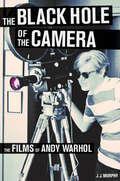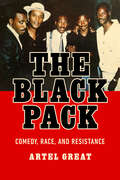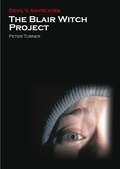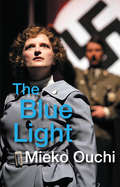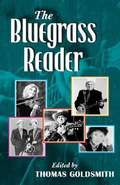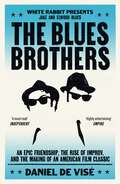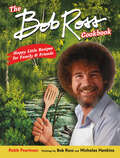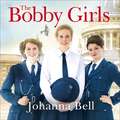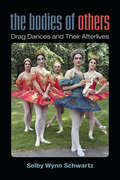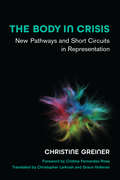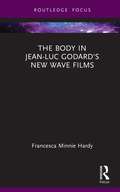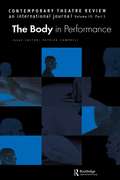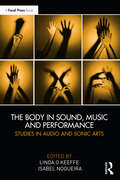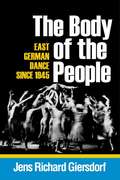- Table View
- List View
The Black Hole of the Camera: The Films of Andy Warhol
by J. J. MurphyAndy Warhol, one of the twentieth century’s major visual artists, was a prolific filmmaker who made hundreds of films, many of them—Sleep, Empire, Blow Job, The Chelsea Girls, and Blue Movie—seminal but misunderstood contributions to the history of American cinema. In the first comprehensive study of Warhol’s films, J.J. Murphy provides a detailed survey and analysis. He discusses Warhol’s early films, sound portraits, involvement with multimedia (including The Velvet Underground), and sexploitation films, as well as the more commercial works he produced for Paul Morrissey in the late 1960s and early 1970s. Murphy’s close readings of the films illuminate Warhol’s brilliant collaborations with writers, performers, other artists, and filmmakers. The book further demonstrates how Warhol’s use of the camera transformed the events being filmed and how his own unique brand of psychodrama created dramatic tension within the works.
The Black Pack: Comedy, Race, and Resistance
by Artel GreatThe Black Pack: Comedy, Race & Resistance is the first book to chronicle the untold history behind the iconic collaborations between a legendary group of comedians—Eddie Murphy, Paul Mooney, Keenen Ivory Wayans, Robert Townsend, and Arsenio Hall—who joined forces as the “Black Pack” in the late 1980s to create a series of socially-charged comedies that revolutionized popular culture and transformed American comedy. Working together as writers, directors, producers, actors, and consultants, the Black Pack created some of the most provocative and enduring Black films and television shows of the twentieth century, including classic productions like In Living Color, Coming to America, Hollywood Shuffle, and The Arsenio Hall Show. The Black Pack collective was armed with a signature comedic style which combined politically-Black satire with edgy social humor that entertained millions, shattered box-office records, and slyly critiqued America’s racial condition. Amid escalating social tensions in the 1980s, the Black Pack’s comedic output transformed anger into art, wielding the cloak of humor as a rebellious tool to confront unjust business practices in Hollywood and challenge racial narratives embedded in American culture. Their work empowered unapologetically Black voices and expanded creative possibilities for Black artists in the entertainment industry. In The Black Pack, Artel Great delivers the most comprehensive analysis of this groundbreaking comedy collective, uncovering how the group’s socially and politically-charged humor defied systemic barriers to achieve unprecedented commercial success and establish a cultural legacy that continues to inspire media creators today and across new generations.
The Black Radical Tragic: Performance, Aesthetics, and the Unfinished Haitian Revolution (America and the Long 19th Century #2)
by Jeremy Matthew Glick2017 Nicolás Guillén Outstanding Book Award presented by the Caribbean Philosophical AssociationAs the first successful revolution emanating from a slave rebellion, the Haitian Revolution remains an inspired site of investigation for a remarkable range of artists and activist-intellectuals in the African Diaspora.In The Black Radical Tragic, Jeremy Matthew Glick examines twentieth-century performances engaging the revolution as laboratories for political thinking. Asking readers to consider the revolution less a fixed event than an ongoing and open-ended history resonating across the work of Atlantic world intellectuals, Glick argues that these writers use the Haitian Revolution as a watershed to chart their own radical political paths, animating, enriching, and framing their artistic and scholarly projects. Spanning the disciplines of literature, philosophy, and political thought, The Black Radical Tragic explores work from Lorraine Hansberry, Sergei Eisenstein, Edouard Glissant, Malcolm X, and others, ultimately enacting a speculative encounter between Bertolt Brecht and C.L.R. James to reconsider the relationship between tragedy and revolution. In its grand refusal to forget, The Black Radical Tragic demonstrates how the Haitian Revolution has influenced the ideas of freedom and self-determination that have propelled Black radical struggles throughout the modern era.
The Blade Runner Experience: The Legacy of a Science Fiction Classic
by Will BrookerSince its release in 1982, Ridley Scott's Blade Runner, based on Philip K. Dick's novel Do Androids Dream of Electric Sheep?, has remained a cult classic through its depiction of a futuristic Los Angeles; its complex, enigmatic plot; and its underlying questions about the nature of human identity. The Blade Runner Experience: The Legacy of a Science Fiction Classic examines the film in a broad context, examining its relationship to the original novel, the PC game, the series of sequels, and the many films influenced by its style and themes. It investigates Blade Runner online fandom and asks how the film's future city compares to the present-day Los Angeles, and it revisits the film to pose surprising new questions about its characters and their world.
The Blade Runner Experience: The Legacy of a Science Fiction Classic
by Will BrookerSince its release in 1982, Ridley Scott's Blade Runner, based on Philip K. Dick's novel Do Androids Dream of Electric Sheep?, has remained a cult classic through its depiction of a futuristic Los Angeles; its complex, enigmatic plot; and its underlying questions about the nature of human identity. The Blade Runner Experience: The Legacy of a Science Fiction Classic examines the film in a broad context, examining its relationship to the original novel, the PC game, the series of sequels, and the many films influenced by its style and themes. It investigates Blade Runner online fandom and asks how the film's future city compares to the present-day Los Angeles, and it revisits the film to pose surprising new questions about its characters and their world.
The Blair Witch Project
by Peter TurnerTells the story of the film from conception and production to audience response.
The Blair Witch Project
by Peter TurnerFew films have had the influence and impact of The Blair Witch Project (1999). Its arrival was a horror cinema palette cleanser after a decade of serial killers and postmodern intertextuality, a bare bones 'found footage' trend setter. In this Devil's Advocate, Peter Turner tells the story of the film from his conception and production then provides a unique analysis of the techniques used, their appeal to audiences and the themes that helped make the film such an international hit, including the pionerring internet marketing.
The Bloodied Nightgown and Other Essays
by Joan AcocellaA collection of the New Yorker critic’s finest essays, which examine the books that reveal and record our world.Joan Acocella was “one of our finest cultural critics” (Edward Hirsch), and she had the rare ability to examine literature and unearth the lives contained within it—its authors, its subjects, and the communities from which it springs. In her hands, arts criticism was a celebration and an investigation, and her essays pulse with unadulterated enthusiasm. As Kathryn Harrison wrote in The New York Times Book Review, “Hers is a vision that allows art its mystery but not its pretensions, to which she is acutely sensitive. What better instincts could a critic have?”The Bloodied Nightgown and Other Essays gathers twenty-four essays from the final decade and a half of Acocella’s career, as well as an introduction that frames her simple preoccupations: “life and art.” In agile, inspired prose, she moves from J. R. R. Tolkien’s translation of Beowulf to the life of Richard Pryor, from surveying profanity to untangling the book of Job. Her appetite (and reading list) knew no bounds. This collection is a joy and a revelation, a library in itself, and Acocella is our dream companion among its shelves.Includes 25 black-and-white images
The Blue Light
by Mieko OuchiLeni Riefenstahl, one hundred years old, is in the office of a young female Hollywood studio executive. Leni’s reason to be there is clear: to make one last desperate pitch to direct her first feature film in fifty years. A thought-provoking contemplation on art, politics, and the seduction of fascism, and a theatrical examination of a woman who danced one perfect dance with the devil and forever changed the way films are made.Leni Riefenstahl was one of the most remarkable and controversial women of the twentieth century. Dancer, actor, photographer, and filmmaker, Riefenstahl caught the eye of Adolf Hitler with her prodigious first film: The Blue Light. A cinematic innovator, her decision to direct Triumph of the Will, got her blacklisted as a filmmaker until her death in 2003 at 101, unrepentant and mostly forgotten.
The Blue Touch Paper: A Memoir
by David Hare"Frank, moving, and beguiling, The Blue Touch Paper is the fascinating story of becoming a writer in the 1960s and 70s when Britain was changing even faster than the author."--Joan Didion David Hare has long been one of Britain's best-known screenwriters and dramatists. He's the author of more than thirty acclaimed plays that have appeared on Broadway, in the West End, and at the National Theatre. He wrote the screenplays for the hugely successful films The Hours, Plenty, and The Reader. Most recently, his play Skylight won the 2015 Tony Award for Best Revival on Broadway. Now, in his debut work of autobiography, "Britain's leading contemporary playwright" (Sunday Times) offers a vibrant and affecting account of becoming a writer amid the enormous flux of postwar England. In his customarily dazzling prose and with great warmth and humor, he takes us from his university days at Cambridge to the swinging 1960s, when he cofounded the influential Portable Theatre in London and took a memorable road trip across America, to his breakthrough successes as a playwright amid the political ferment of the '70s and the moment when Margaret Thatcher came to power at the end of the decade. Through it all, Hare sets the progress of his own life against the dramatic changes in postwar England, in which faith in hierarchy, religion, empire, and the public good all withered away. Filled with indelible glimpses of such figures as Alfred Hitchcock, Laurence Olivier, Tennessee Williams, Helen Mirren, and Joseph Papp, The Blue Touch Paper is a powerful evocation of a society in transition and a writer in the making.
The Bluegrass Guitar Style of Charles Sawtelle
by Daniel MillerBook description from the Flatpicking Guitar magazine website (where I bought it!) Charles Sawtelle is one of the most innovative guitar players in bluegrass history. His bluesy syncopated solos with the popular bluegrass band Hot Rize proved true the famous saying 'less is more.' Charles is a true master of tone, timing, and taste in bluegrass guitar playing and his exciting and innovative solos have thrilled bluegrass fans around the world. This comprehensive book provides you with a Sawtelle biography, an extensive interview with Charles, a section on Charles' rhythm style, 27 transcriptions of Sawtelle solos in both standard notation and tablature, with notes accompanying each solo transcription and dozens of photographs of Charles and Hot Rize. All fans of Hot Rize will love this book. Level: Intermediate, Advanced. Even though the musical notation and tablature could not be reproduced in this version, there is much text which helps to reveal the nature of Sawtelle's guitar playing. Also, many of the big names in today's bluegrass tell why they think he was one of the best. (Sawtelle passed away in 1999.)
The Bluegrass Reader
by Thomas GoldsmithLike rock 'n' roll, bluegrass exploded out of a post-World War II atmosphere in which more Americans opened their ears to more different kinds of music than ever before. All around the country musicians were searching for new sounds and approaches: country blues went fully electric in Chicago, bebop boiled over as jazz hit the hippest notes yet, and country music followed Hank Williams into new, sexier, harder-hitting territory. The developments in bluegrass proved every bit as galvanic. In The Bluegrass Reader, Thomas Goldsmith joins his insights as a journalist with a lifetime of experience in bluegrass to capture the full story of this dynamic and beloved music. Inspired by the question, what articles about bluegrass would you want to have with you on a desert island? he has assembled a captivating, fun-to-read collection that brings together a wide range of the very best in bluegrass writing.
The Blues Brothers: An Epic Friendship, the Rise of Improv, and the Making of an American Film Classic
by Daniel de ViséThe Blues Brothers hit theatres on June 20, 1980. Their scripted mission was to save a local Chicago orphanage; but Aykroyd, who conceived and wrote much of the film, had a greater mission: to honour the then-seemingly forgotten tradition of rhythm and blues, some of whose greatest artists - Aretha Franklin, James Brown, John Lee Hooker, Cab Calloway, Ray Charles - made the film as unforgettable as its wild car chases. Much delayed and vastly over budget, beset by mercurial and oft drugged-out stars, The Blues Brothers opened to outraged reviews. However, in the 44 years since it has been acknowledged a classic: inducted into the National Film Registry for its cultural significance, even declared a 'Catholic classic' by the Church itself, and re-aired thousands of times on television to huge worldwide audiences. It is, undeniably, one of the most significant films of the 20th century.The saga behind The Blues Brothers, as Daniel de Visé reveals, is epic, encompassing the colourful childhoods of Belushi and Aykroyd; the comedic revolution sparked by Harvard's Lampoon and Chicago's Second City; the birth and anecdote-rich, drug-filled early years of Saturday Night Live, where the Blues Brothers were born as an act amidst turmoil and rivalry; and, of course, the indelible behind-the-scenes narrative of how the film was made, scene by memorable scene. Based on original research and dozens of interviews probing the memories of principals from director John Landis and producer Bob Weiss to Aykroyd himself, The Blues Brothers illuminates an American masterpiece while vividly portraying the creative geniuses behind modern comedy.
The Blues Brothers: An Epic Friendship, the Rise of Improv, and the Making of an American Film Classic
by Daniel de ViséThe Blues Brothers hit theatres on June 20, 1980. Their scripted mission was to save a local Chicago orphanage; but Aykroyd, who conceived and wrote much of the film, had a greater mission: to honour the then-seemingly forgotten tradition of rhythm and blues, some of whose greatest artists - Aretha Franklin, James Brown, John Lee Hooker, Cab Calloway, Ray Charles - made the film as unforgettable as its wild car chases. Much delayed and vastly over budget, beset by mercurial and oft drugged-out stars, The Blues Brothers opened to outraged reviews. However, in the 44 years since it has been acknowledged a classic: inducted into the National Film Registry for its cultural significance, even declared a 'Catholic classic' by the Church itself, and re-aired thousands of times on television to huge worldwide audiences. It is, undeniably, one of the most significant films of the 20th century.The saga behind The Blues Brothers, as Daniel de Visé reveals, is epic, encompassing the colourful childhoods of Belushi and Aykroyd; the comedic revolution sparked by Harvard's Lampoon and Chicago's Second City; the birth and anecdote-rich, drug-filled early years of Saturday Night Live, where the Blues Brothers were born as an act amidst turmoil and rivalry; and, of course, the indelible behind-the-scenes narrative of how the film was made, scene by memorable scene. Based on original research and dozens of interviews probing the memories of principals from director John Landis and producer Bob Weiss to Aykroyd himself, The Blues Brothers illuminates an American masterpiece while vividly portraying the creative geniuses behind modern comedy.
The Blues Brothers: An Epic Friendship, the Rise of Improv, and the Making of an American Film Classic
by Daniel de ViséThe Blues Brothers hit theatres on June 20, 1980. Their scripted mission was to save a local Chicago orphanage; but Aykroyd, who conceived and wrote much of the film, had a greater mission: to honour the then-seemingly forgotten tradition of rhythm and blues, some of whose greatest artists - Aretha Franklin, James Brown, John Lee Hooker, Cab Calloway, Ray Charles - made the film as unforgettable as its wild car chases. Much delayed and vastly over budget, beset by mercurial and oft drugged-out stars, The Blues Brothers opened to outraged reviews. However, in the 44 years since it has been acknowledged a classic: inducted into the National Film Registry for its cultural significance, even declared a 'Catholic classic' by the Church itself, and re-aired thousands of times on television to huge worldwide audiences. It is, undeniably, one of the most significant films of the 20th century.The saga behind The Blues Brothers, as Daniel de Visé reveals, is epic, encompassing the colourful childhoods of Belushi and Aykroyd; the comedic revolution sparked by Harvard's Lampoon and Chicago's Second City; the birth and anecdote-rich, drug-filled early years of Saturday Night Live, where the Blues Brothers were born as an act amidst turmoil and rivalry; and, of course, the indelible behind-the-scenes narrative of how the film was made, scene by memorable scene. Based on original research and dozens of interviews probing the memories of principals from director John Landis and producer Bob Weiss to Aykroyd himself, The Blues Brothers illuminates an American masterpiece while vividly portraying the creative geniuses behind modern comedy.
The Blues of Flats Brown
by Walter Dean MyersTo escape an abusive master, a junkyard dog named Flats runs away and makes a name for himself from Mississippi to New York City playing blues on his guitar.
The Bob Ross Cookbook: Happy Little Recipes for Family and Friends
by Robb PearlmanCook craveable comfort food favorites and find joy in your kitchen's happy little accidents with this one-of-a-kind cookbook for Bob Ross fans and aspiring chefs of all ages.Featuring comfort-food favorites inspired by Bob Ross's iconic words and scenic landscapes, this collection of recipes is as delightful and distinctive as the artist himself.The Bob Ross Cookbook: Happy Little Recipes for Family and Friends includes recipes and entertaining ideas based on the art and wisdom of Bob Ross, evoking the painter's signature wisdom and tone. Learn how to apply his laid back, meditative approach to delicious meals such as:Happy Little Roasted ChickenCurly-Topped Veggie Mac and CheeseNothing-to-It Pot RoastVan Dyke Browned MeatballsGolden Sunset Shrimp ScampiUpstream Salmon CroquettesBrunch Palette QuicheCabin-Roasted VegetablesAnd much more!Peppered with Bob's own art and quotes and featuring full-color food illustrations from a certified Bob Ross painting instructor, this cookbook features easy-to-follow recipes that include "Bravery Test" sidebars for when you want to take it up a notch. You know The Joy of Painting; now learn the joy of cooking with Bob Ross.
The Bobby Girls: The Bobby Girls, Book One (The Bobby Girls)
by Johanna Bell1914. While their men fight in France, at home in Britain women are finally seizing the opportunity to make a difference . . .Maggie and her new friends Annie, Irene and Sarah come from very different backgrounds, but they've got one thing in common: they've all signed up for the Women's Police Volunteers. They can't wait to show the men just what they're made of.But soon, Maggie realises she's in over her head. Hiding her involvement with the WPV from her tyrannous father is becoming ever more difficult, and when she bumps into an old acquaintance with a big chip on his shoulder, the dangers of her new life become all too clear . . .As she and the girls work to find their feet on the beat, will their friendship get her through the darkest of times? A gritty, uplifting new saga series about the first ever female police officers, set at the outbreak of the First World War - perfect for fans of Dilly Court, Daisy Styles and Call the Midwife.(P) 2019 Hodder & Stoughton Ltd
The Bodies That Were Not Ours: And Other Writings
by Coco FuscoInterdisciplinary artist and writer Coco Fusco is one of North America's leading interpreters of intercultural theory and practice. This volume gathers together her finest writings since 1995 and includes critical essays by Jean Fisher and Caroline Vercoe that interpret her work.Engaging and provocative, these essays, interviews, performance scripts and fotonovelas take readers on a tour of our current multicultural landscape. Fusco explores such issues as sex tourism in Cuba as a barometer of the island's entry into the global economy, Frantz Fanon's theorization of metropolitan blackness, and artistic and net activist responses to the effects of free trade on the Mexican populace. She interviews such postcolonial personnae as Isaac Julien, Hilton Als and Tracey Moffatt. Approaching the dynamics of cultural fusion from many angles, Fusco's satires, commentaries, and sociological inquiries collapse boundaries, and form a sustained meditation on how the forces of globalization impact upon the making of art.
The Bodies of Others: Drag Dances and Their Afterlives (Triangulations: Lesbian/Gay/Queer Theater/Drama/Performance)
by Selby Wynn SchwartzThe Bodies of Others explores the politics of gender in motion. From drag ballerinas to faux queens, and from butoh divas to the club mothers of modern dance, the book delves into four decades of drag dances on American stages. Drag dances take us beyond glittery one-liners and into the spaces between gender norms. In these backstage histories, dancers give their bodies over to other selves, opening up the category of realness. The book maps out a drag politics of embodiment, connecting drag dances to queer hope, memory, and mourning. There are aging étoiles, midnight shows, mystical séances, and all of the dust and velvet of divas in their dressing-rooms. But these forty years of drag dances are also a cultural history, including Mark Morris dancing the death of Dido in the shadow of AIDS, and the swans of Les Ballets Trockadero de Monte Carlo sketching an antiracist vision for ballet. Drawing on queer theory, dance history, and the embodied practices of dancers themselves, The Bodies of Others examines the ways in which drag dances undertake the work of a shared queer and trans politics.
The Body in Crisis: New Pathways and Short Circuits in Representation (Studies in Dance: Theories and Practices)
by Christine GreinerThe Body in Crisis introduces the English-speaking world to the work of leading Latin American dance scholar and philosopher of the body, Christine Greiner. The book offers an innovative set of tools with which to examine the role of moving bodies and bodily actions in relation to worldwide concerns, including identity politics, alterity, migration, and belonging. The book places the concept of bodymedium in dialogue with the work of Giorgio Agamben to investigate notions of alterity, and shows how an understanding of the body-environment continuum can shed light on things left unnamed and at the margins. Greiner’s analyses draw from a broad range of theory concerned with the epistemology of the body, including cognitive science, political philosophy, evolutionary biology, and performance studies to illuminate radical experiences that question the limits of the body. Her analysis of the role that bodies play in negotiations of power relations offers an original and unprecedented contribution to the field of dance studies and expands its scope to recognize theoretical models of inquiry developed in the Global South.
The Body in Jean-Luc Godard's New Wave Films (Routledge Focus on Film Studies)
by Francesca Minnie HardyThis original study examines the representation of the body in French New Wave films through discussion of a series of films by Jean-Luc Godard, perhaps the central figure of the French New Wave. Through analysis of À bout de souffle, Une femme est une femme, Le Mépris and Alphaville, alongside discussion of some of Godard’s lesser-known French New Wave films, the book explores the interrelation between bodies, books and bathrooms that they facilitate. In so doing, it aims to destabilise the French New Wave’s myth of male exceptionalism and denaturalise the gender dynamic most commonly viewed at its heart, revealing that the women who make up a fundamental part of its fabric are not textually trapped by Godard’s authorial presence. Instead, their corporeality disrupts any purported authorial and national ownership of their bodies. Given the enduring popularity and visibility of the French New Wave, and of Jean-Luc Godard, in universities and journals, The Body in Jean-Luc Godard’s New Wave Films will appeal to scholars in the disciplines of French and film studies, as well as to undergraduate and postgraduate students of these disciplines.
The Body in Performance
by Patrick CampbellLively yet intriguing, The Body in Performance is a varied collection of essays about this much-discussed area. Posing the question "Why this current preoccupation with the performed body?" the collection of specially commissioned essays from both academics and practitioners - in some cases one and the same person - considers such cutting edge topics as the abject body and performance, censorship and live art, the presentation of violence on stage, carnal art, and the vexed issue of mimesis in the theatre. Drawing variously on the work of Franko B., Orlan, Annie Sprinkle, Karen Finley, and Forced Entertainment, it concludes with a creative piece about a 'Famous New York Performance Artist.' Contributors include Rebecca Schneider whose book The Explicit Body in Performance is a key text in this area, and Joan Lipkin, director and writer.
The Body in Sound, Music and Performance: Studies in Audio and Sonic Arts
by Linda O KeeffeThe Body in Sound, Music and Performance brings together cutting-edge contributions from women working on and researching contemporary sound practice. This highly interdisciplinary book features a host of international contributors and places emphasis on developments beyond the western world, including movements growing across Latin America. Within the book, the body is situated as both the site and centre for knowledge making and creative production. Chapters explore how insightful theoretical analysis, new methods, innovative practises, and sometimes within the socio-cultural conditions of racism, sexism and classicism, the body can rise above, reshape and deconstruct understood ideas about performance practices, composition, and listening/sensing. This book will be of interest to both practitioners and researchers in the fields of sonic arts, sound design, music, acoustics and performance.
The Body of the People
by Jens Richard GiersdorfThe Body of the Peopleis the first comprehensive study of dance and choreography in East Germany. More than twenty years after the fall of the Berlin Wall, Jens Richard Giersdorf investigates a national dance history in the German Democratic Republic, from its founding as a Communist state that supplanted the Soviet zone of occupation in 1949 through the aftermath of its collapse forty years later, examining complex themes of nationhood, ideology, resistance, and diaspora through an innovative mix of archival research, critical theory, personal narrative, and performance analysis. Giersdorf looks closely at uniquely East German dance forms-including mass exercise events, national folk dances, Marxist-Leninist visions staged by the dance ensemble of the armed forces, the vast amateur dance culture, East Germany’s version of Tanztheater, and socialist alternatives to rock ‘n roll-to demonstrate how dance was used both as a form of corporeal utopia and of embodied socialist propaganda and indoctrination. The Body of the Peoplealso explores the artists working in the shadow of official culture who used dance and movement to critique and resist state power, notably Charlotte von Mahlsdorf, Arila Siegert, and Fine Kwiatkowski. Giersdorf considers a myriad of embodied responses to the Communist state even after reunification, analyzing the embodiment of the fall of the Berlin Wall in the works of Jo Fabian and Sasha Waltz, and the diasporic traces of East German culture abroad, exemplified by the Chilean choreographer Patricio Bunster.
